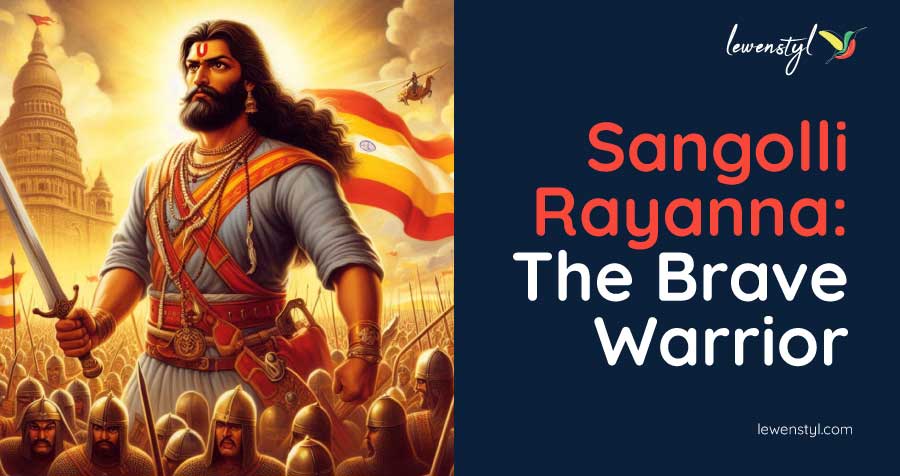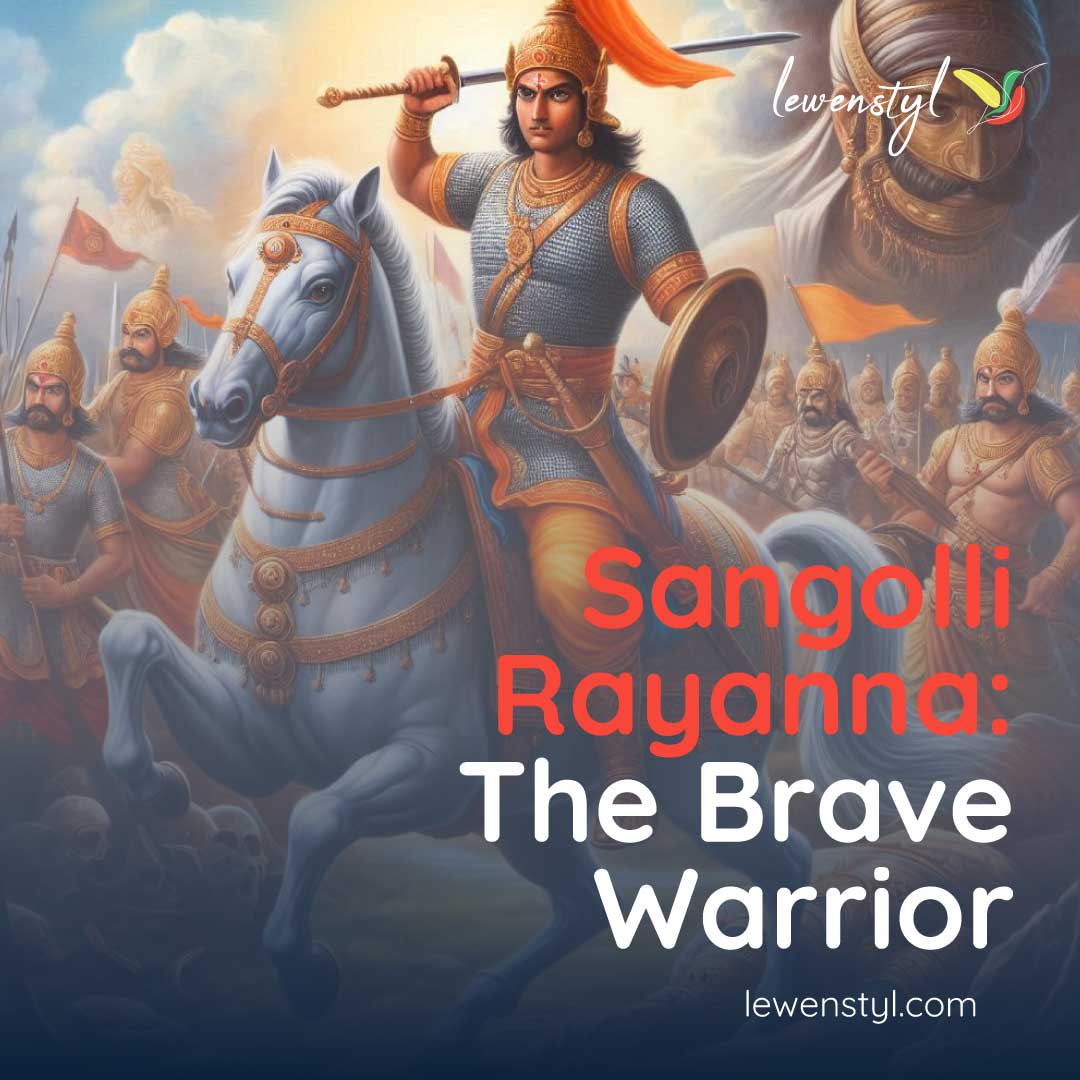
Sangolli Rayanna, born on August 15, 1798, in the village of Sangolli in Belagavi district, Karnataka, is celebrated as one of India’s most valiant freedom fighters. His life and legacy are a testament to his unwavering commitment to resisting British colonial rule and his dedication to the cause of Indian independence.
Early Life and Background
Rayanna was born into a Kuruba family, a community traditionally engaged in shepherding. From a young age, he exhibited qualities of leadership and bravery, which would later define his role in the fight against British oppression. His early life in the village of Sangolli was marked by the values of courage and resilience, which were instilled in him by his family and community.
Rise to Prominence
Rayanna’s rise to prominence began when he joined the military of the princely state of Kittur, which was ruled by Rani Chennamma. Kittur was a small but strategically significant kingdom in Karnataka. Rayanna quickly rose through the ranks to become a senior commander in the Kittur army. His loyalty and dedication to Rani Chennamma and the kingdom were unwavering.
In 1824, Rani Chennamma led a rebellion against the British East India Company in response to the Doctrine of Lapse, a policy that allowed the British to annex any princely state without a male heir. Rayanna played a crucial role in this rebellion, demonstrating his military prowess and strategic acumen. Although the rebellion was ultimately unsuccessful, it marked the beginning of Rayanna’s lifelong struggle against British rule.
The Insurgency
After the failed rebellion of 1824, Rayanna continued to resist British domination. He was deeply incensed by the British confiscation of his lands and the heavy taxation imposed on the local population. Determined to free his homeland from colonial rule, Rayanna embarked on a guerrilla warfare campaign against the British.
Lacking the resources to raise a regular army, Rayanna recruited forces from among the local peasantry, who were equally discontented with British rule. His insurgents targeted British administration buildings, military outposts, and local treasuries. Rayanna’s ability to mobilize and lead a peasant army was a testament to his charisma and leadership skills.
One of Rayanna’s key strategies was to remain constantly on the move, avoiding direct confrontations with larger British forces. This guerrilla warfare tactic allowed him to strike at the British and then disappear into the dense forests and hills of Karnataka. His insurgency was funded through taxes collected from local landlords and the loot obtained from plundering British treasuries.
Capture and Execution
Despite his relentless efforts, Rayanna’s insurgency faced numerous challenges. In April 1830, he was finally captured by the British, along with Shivalingappa, the adopted son of Rani Chennamma. Rayanna was tried in a British court and sentenced to death. On January 26, 1831, at the age of thirty-three, he was executed by hanging from a banyan tree near the village of Nandagad12.
Rayanna’s execution was a significant event in the history of Karnataka’s struggle for independence. His bravery and sacrifice left an indelible mark on the hearts and minds of the people. After his death, Rayanna was buried near Nandagad, and a banyan sapling was planted on his grave by his close associate, Sangolli Bichugatti Channabasappa. This banyan tree stands as a living memorial to Rayanna’s legacy.
Legacy and Commemoration
Sangolli Rayanna’s legacy continues to inspire generations of Indians. He is remembered not only as a warrior but also as a symbol of resistance against colonial oppression. His life and sacrifices have been commemorated in various ways.
In Karnataka, Rayanna is celebrated as a folk hero. Numerous schools, colleges, and institutions have been named after him. Statues and memorials have been erected in his honor, and his story is taught in schools to instill a sense of pride and patriotism in young minds.
Rayanna’s life has also been the subject of several Kannada-language films, including “Kranthiveera Sangolli Rayanna” (1967) and “Krantiveera Sangolli Rayanna” (2012). These films have played a crucial role in keeping his memory alive and introducing his story to a wider audience.
Rayanna’s Broader Impact
Rayanna’s struggle was not just against the British but also against the feudal landlords who exploited the local population. He mobilized peasants from various communities, including Kuruba, Beda, Jain, Lingayat, Siddhi, Muslim, and Panchamasali, to fight against both colonial and feudal oppression2. His inclusive approach and commitment to social justice made him a unifying figure in the region.
Rayanna’s efforts to eliminate caste differences among his warriors and promote collective sharing of resources, known as dasoha, were revolutionary for his time. He recognized the importance of unity among the oppressed and worked tirelessly to build a bond of fraternity among his followers2.
Conclusion
Sangolli Rayanna’s life is a shining example of courage, resilience, and unwavering commitment to the cause of freedom. His legacy continues to inspire and remind us of the sacrifices made by countless individuals in the struggle for India’s independence. As we remember Sangolli Rayanna, we honor not only his bravery but also his vision of a just and equitable society.
Rayanna’s story is a testament to the power of ordinary individuals to challenge oppression and fight for justice. His life and legacy serve as a source of inspiration for all those who strive for a better and more just world.
Please Read this too : Amitabh Bachchan: The Iconic Journey of Bollywood’s Megastar










I have been surfing online more than 3 hours today yet I never found any interesting article like yours It is pretty worth enough for me In my opinion if all web owners and bloggers made good content as you did the web will be much more useful than ever before
Insanont Good post! We will be linking to this particularly great post on our site. Keep up the great writing
Blue Techker This is my first time pay a quick visit at here and i am really happy to read everthing at one place
Wonderful beat I wish to apprentice while you amend your web site how could i subscribe for a blog web site The account aided me a acceptable deal I had been a little bit acquainted of this your broadcast provided bright clear idea
Wow amazing blog layout How long have you been blogging for you made blogging look easy The overall look of your web site is magnificent as well as the content
Generally I do not read article on blogs, but I wish to say that this write-up very compelled me to try and do so! Your writing style has been surprised me. Thank you, quite nice post.
Clochant I just like the helpful information you provide in your articles
Its great as your other content : D, thanks for posting. “I catnap now and then, but I think while I nap, so it’s not a waste of time.” by Martha Stewart.
Hi Neat post Theres an issue together with your web site in internet explorer may test this IE still is the marketplace chief and a good component of people will pass over your fantastic writing due to this problem
We investigated the relationship between quantity and location of lymphocytic infiltrate at diagnosis with clinical outcome in 2009 node positive BC samples from the BIG 02 98 adjuvant phase III trial comparing anthracycline only CT doxorubicin followed by cyclophosphamide, methotrexate, and fluorouracil CMF or doxorubicin plus cyclophosphamide followed by CMF versus CT combining doxorubicin and docetaxel doxorubicin plus docetaxel followed by CMF or doxorubicin followed by docetaxel followed by CMF how to buy priligy im 16 years old
pwq0nj
Bwer Company is a top supplier of weighbridge truck scales in Iraq, providing a complete range of solutions for accurate vehicle load measurement. Their services cover every aspect of truck scales, from truck scale installation and maintenance to calibration and repair. Bwer Company offers commercial truck scales, industrial truck scales, and axle weighbridge systems, tailored to meet the demands of heavy-duty applications. Bwer Company’s electronic truck scales and digital truck scales incorporate advanced technology, ensuring precise and reliable measurements. Their heavy-duty truck scales are engineered for rugged environments, making them suitable for industries such as logistics, agriculture, and construction. Whether you’re looking for truck scales for sale, rental, or lease, Bwer Company provides flexible options to match your needs, including truck scale parts, accessories, and software for enhanced performance. As trusted truck scale manufacturers, Bwer Company offers certified truck scale calibration services, ensuring compliance with industry standards. Their services include truck scale inspection, certification, and repair services, supporting the long-term reliability of your truck scale systems. With a team of experts, Bwer Company ensures seamless truck scale installation and maintenance, keeping your operations running smoothly. For more information on truck scale prices, installation costs, or to learn about their range of weighbridge truck scales and other products, visit Bwer Company’s website at bwerpipes.com.
An fascinating dialogue is worth comment. I think that you should write more on this matter, it won’t be a taboo topic however usually persons are not enough to speak on such topics. To the next. Cheers
Your blog is a beacon of light in the often murky waters of online content. Your thoughtful analysis and insightful commentary never fail to leave a lasting impression. Keep up the amazing work!
Wow superb blog layout How long have you been blogging for you make blogging look easy The overall look of your site is magnificent as well as the content
Fantastic site Lots of helpful information here I am sending it to some friends ans additionally sharing in delicious And of course thanks for your effort
I like what you guys are up too. Such intelligent work and reporting! Carry on the excellent works guys I’ve incorporated you guys to my blogroll. I think it’ll improve the value of my site :).
Noodlemagazine naturally like your web site however you need to take a look at the spelling on several of your posts. A number of them are rife with spelling problems and I find it very bothersome to tell the truth on the other hand I will surely come again again.
Normally I do not read article on blogs however I would like to say that this writeup very forced me to try and do so Your writing style has been amazed me Thanks quite great post
otc fertility meds Although contraceptive use led to reduce the number of unintended pregnancies, however approximately 33 million contraceptive users report about accidental pregnancy
Mat6tube This is truly remarkable, You’re an outstanding blogger. I’ve joined your feed and can’t wait to see more of your excellent posts. Plus, I’ve shared your site on my social media accounts!
This web site is really a walk-through for all of the info you wanted about this and didn’t know who to ask. Glimpse here, and you’ll definitely discover it.
Great wordpress blog here.. It’s hard to find quality writing like yours these days. I really appreciate people like you! take care
Do you mind if I quote a couple of your articles as long as I provide credit and sources back to your webpage? My blog is in the exact same niche as yours and my users would genuinely benefit from some of the information you provide here. Please let me know if this ok with you. Appreciate it!
Hi! Quick question that’s entirely off topic. Do you know how to make your site mobile friendly? My weblog looks weird when viewing from my iphone4. I’m trying to find a template or plugin that might be able to correct this issue. If you have any suggestions, please share. Many thanks!
Thank you for the auspicious writeup It in fact was a amusement account it Look advanced to far added agreeable from you However how can we communicate
Aw, this was a very nice post. In concept I would like to put in writing like this additionally – taking time and actual effort to make a very good article… but what can I say… I procrastinate alot and by no means appear to get something done.
Thank you for sharing superb informations. Your website is very cool. I’m impressed by the details that you have on this website. It reveals how nicely you perceive this subject. Bookmarked this website page, will come back for extra articles. You, my friend, ROCK! I found just the information I already searched everywhere and simply could not come across. What a great web-site.
7n8vov
qpuing
Somebody essentially help to make significantly articles Id state This is the first time I frequented your web page and up to now I surprised with the research you made to make this actual post incredible Fantastic job
Your blog has become an indispensable resource for me. I’m always excited to see what new insights you have to offer. Thank you for consistently delivering top-notch content!
Loving the info on this web site, you have done great job on the posts.
Greenpark, Oran ve Çukurambar gibi bölgelerde escort arıyorsanız kesinlikle buraya göz atın. Kalite, konfor ve gizlilik bir arada.
маркетплейс аккаунтов соцсетей https://birzha-akkauntov-online.ru
гарантия при продаже аккаунтов маркетплейс аккаунтов
платформа для покупки аккаунтов профиль с подписчиками
маркетплейс аккаунтов соцсетей продать аккаунт
гарантия при продаже аккаунтов маркетплейс аккаунтов
услуги по продаже аккаунтов магазин аккаунтов
маркетплейс аккаунтов купить аккаунт